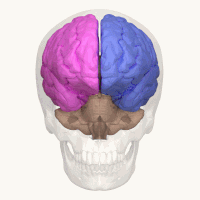
Photo from wikipedia
Cognitive functions, for example speech processing, are distributed asymmetrically in the two hemispheres that mostly have homologous anatomical structures. Dichotic listening is a well-established paradigm to investigate hemispherical lateralization of… Click to show full abstract
Cognitive functions, for example speech processing, are distributed asymmetrically in the two hemispheres that mostly have homologous anatomical structures. Dichotic listening is a well-established paradigm to investigate hemispherical lateralization of speech. However, the mixed results of dichotic listening, especially when using tonal languages as stimuli, complicates the investigation of functional lateralization. We hypothesized that the inconsistent results in dichotic listening are due to an interaction in processing a mixture of acoustic and linguistic attributes that are differentially processed over the two hemispheres. In this study, a within-subject dichotic listening paradigm was designed, in which different levels of speech and linguistic information was incrementally included in different conditions that required the same tone identification task. A left ear advantage (LEA), in contrast with the commonly found right ear advantage (REA) in dichotic listening, was observed in the hummed tones condition, where only the slow frequency modulation of tones was included. However, when phonemic and lexical information was added in simple vowel tone conditions, the LEA became unstable. Furthermore, ear preference became balanced when phonological and lexical-semantic attributes were included in the consonant-vowel (CV), pseudo-word, and word conditions. Compared with the existing REA results that use complex vowel word tones, a complete pattern emerged gradually shifting from LEA to REA. These results support the hypothesis that an acoustic analysis of suprasegmental information of tones is preferably processed in the right hemisphere, but is influenced by phonological and lexical semantic processes residing in the left hemisphere. The ear preference in dichotic listening depends on the levels of speech and linguistic analysis and preferentially lateralizes across the different hemispheres. That is, the manifestation of functional lateralization depends on the integration of information across the two hemispheres.
Journal Title: Neuropsychologia
Year Published: 2020
Link to full text (if available)
Share on Social Media: Sign Up to like & get
recommendations!